
This post is one year old. A newer version of the post with stats for 2023 can be found here: “A deep dive into VALORANT stats in 2023: Is the game still balanced?”
Riot Games’ VALORANT has recently turned two years. Being a young game, it’s still not a real contender to the big three esports; League of Legends, Dota 2 and Counter-Strike: Global Offensive. Nevertheless, it has quickly built momentum in the esports space and is seeing steady growth as well as player count. We decided to look into statistics from different aspects of the game to understand its current state.
At Abios, we’ve covered the esports scene for VALORANT since its nascence. First, we only compiled the matches, tournaments and results. When it became clear how popular the game had become, we decided to add Computer Vision to our VALORANT offering. It increased our reach and allowed us to provide our customers with in-depth statistics from in-game events. Since then, we’ve seen solid demand for statistics and data from all tournaments we cover.
With access to data from the latest esports matches in the game, we decided to deep dive into maps, agents, weapons and abilities to find out how balanced VALORANT is. The data was collected from 967 matches in official tournaments between 2022-03-04 and 2022-05-12.
What weapons are worth buying in VALORANT?
When measuring the effectiveness of different weapons in VALORANT, we decided to look at the pick rate and kill rate of all weapons, excluding sidearms. There are a few things that pop out, such as the popularity of the Vandal, and the lacklustre experience of the Operator.
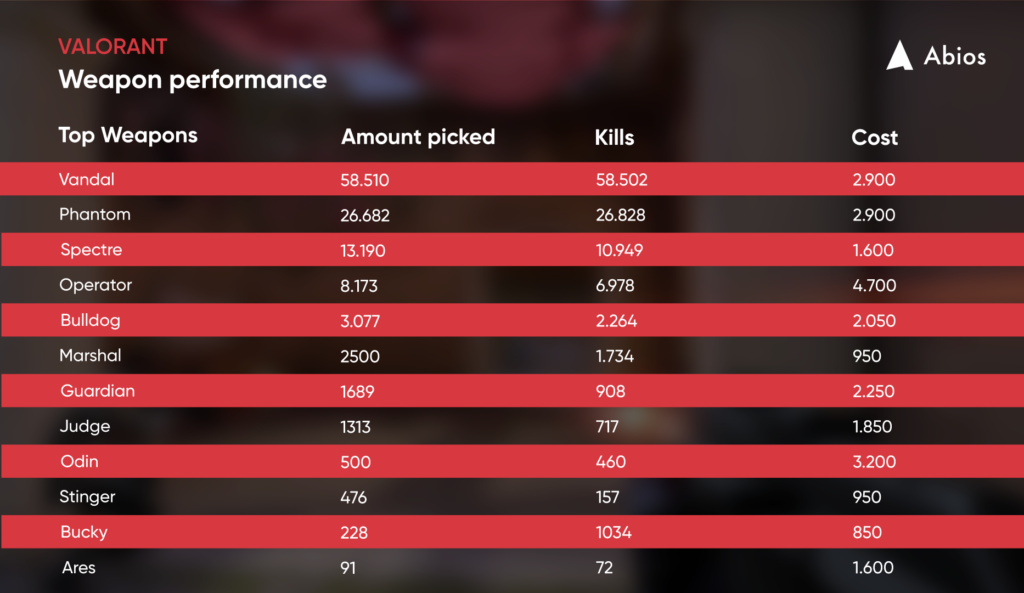
The Vandal and Phantom are the rifles. They are the most common guns after teams have enough money to be able to buy a full round of equipment. This usually happens around round 3. The guns differ in their performance at range and fire rate. Vandal is better at longer distances, being able to kill with one shot to the head. Phantom has a higher fire rate, making it better at mid-range distances.
It seems like pro players have heavily favoured the VANDAL, as it is picked twice as much as the Phantom. While the kill and pick ratio of Vandal and Phantom are roughly 1:1, the same cannot be said for the Operator.
The economy cap in VALORANT is at 9000 coins. The Operator costs 4,700 coins. Thus, it’s a very expensive buy. It necessitates players getting a lot of value out of it in return for the investment. Otherwise, it strikes a detrimental blow to the player and teams’ economy.
With these costs, players already have an economical incentive to pick Vandal or Phantom over the Operator. Without gazing at the worth an Operator holds in regard to holding angles and sites, the statistics tell us players should look to Vandal and Phantom to get kills, rather than the sniper.
The data suggests that players don’t get kills on every round for most guns. However, an outlier here is Bucky. The weapon gains 4.5 kills on average for its players. Although Bucky is often bought as a last resort when players are in economical crunches, the numbers suggest it’s well worth the pick.
How balanced are VALORANT agents and is there a “meta”?
As we’ve seen in the past with League of Legends, Dota 2 and even Overwatch, games where there are distinct, different playable characters often have something called a “meta”. It occurs when some characters are more viable to play than others and consequently see more play.
A meta can be determined by lots of factors, but essentially it boils down to how much a specific character can contribute to the team. It can either be through kills, utility or team play, but it’s usually a mix of all three.
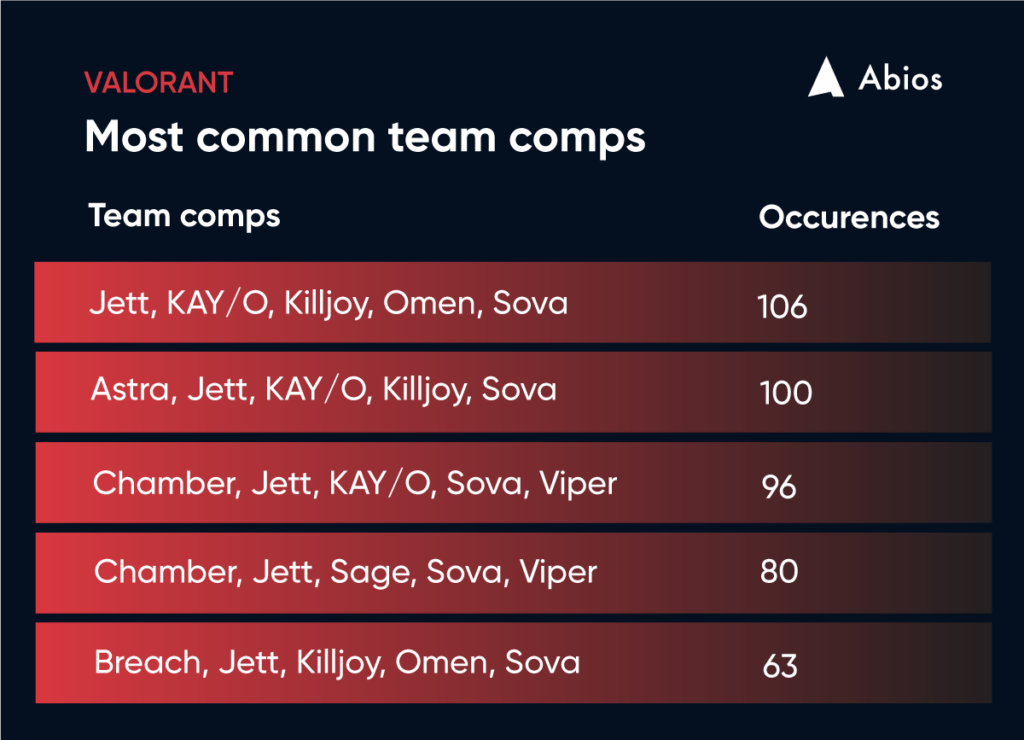
A meta occurring almost seems like a law of physics at this point in character-based esports games. It can break the game and make the esports scene stale if specific champions are too overpowered or see too much play. (Everyone remembers GOATS in Overwatch right?)
In VALORANT specifically, we’ve seen a specific meta grow for a time. There have been two dominant agents above all others: Jett and Sova.
Jett has been especially prominent with a pick rate of over 70 % in pro games. With her powerful, accurate throwing knives and high level of vertical movement, she has indeed been a force to be reckoned with. Not to mention her ability to dash away quickly to safety whenever facing a threat. It has made her one of the most prominent Operator players. She has been allowed to take dangerous angles to shoot down the enemy from afar while being saved by her dash.
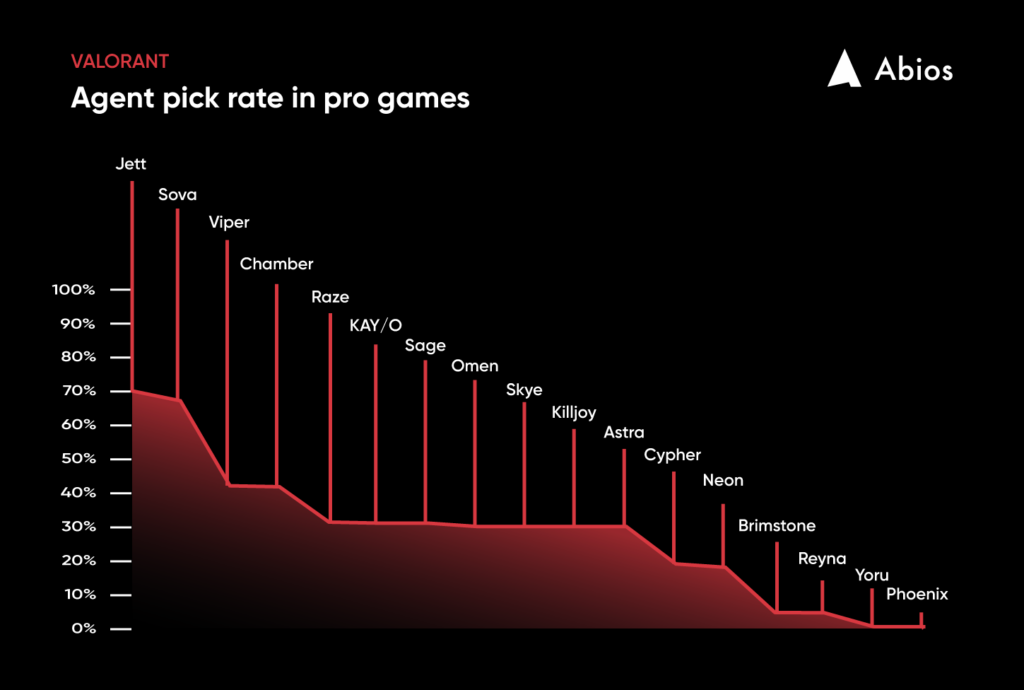
With that said, Riot Games have nerfed her and Sova a great deal, which (hopefully) gives space for new agents to flourish.
Agent abilities – and how they impact the kill feed
Abilities in VALORANT are what really sets it apart from traditional FPS titles such as CS:GO or Call of Duty, although the latter has displayed some colourful touches recently.
CS:GO players enjoy purchasing Molotov cocktails, smokes, flashes and other supplies from the in-game store. VALORANT players can instead choose between agents giving them different abilities. These abilities mirror the supplies in the CS:GO store many times. Nevertheless, there are also a large set of abilities with functionality unique to VALORANT.
While the data is skewed due to some agents being picked more than others, we’ve compiled a list of the abilities which has contributed to the largest amount of kills in pro play:
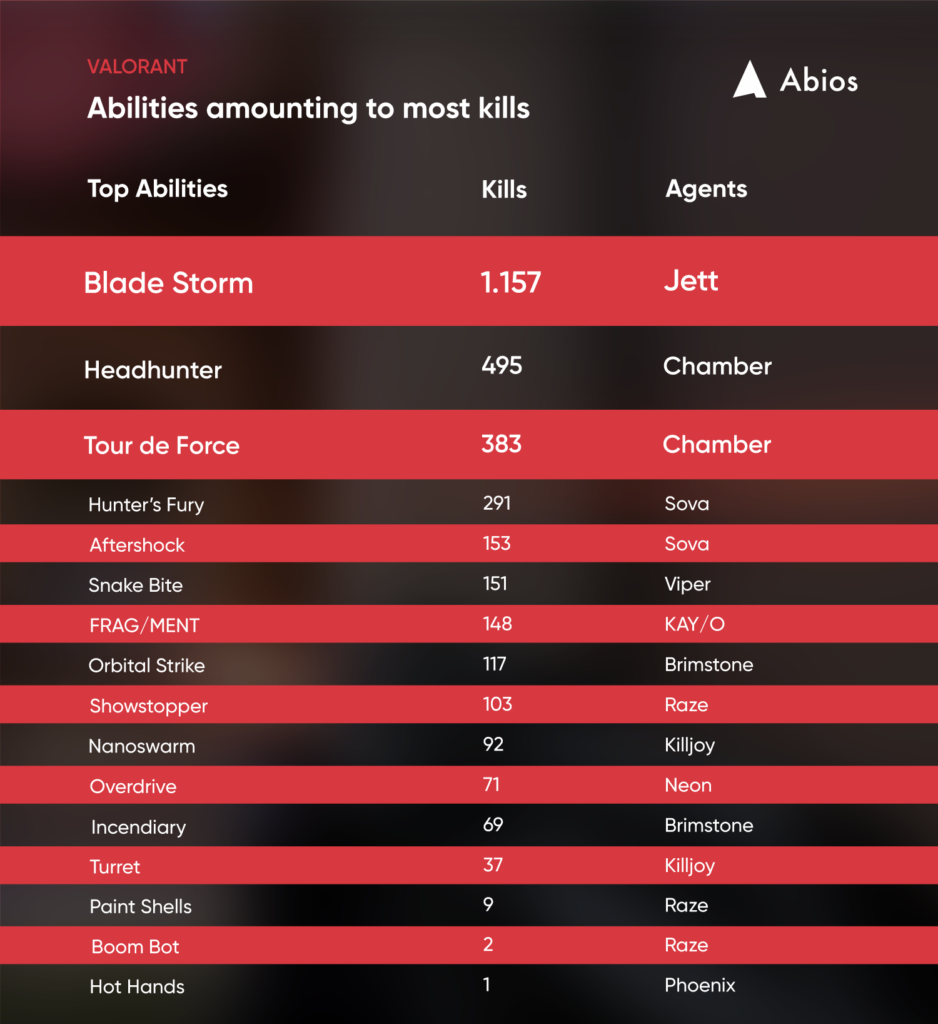
The win rate of different sides on VALORANT maps
The maps on VALORANT are fairly balanced on attacker and defender sites, at least if compared to CS:GO. The most significant difference we observed was on Split. The defending side won 5.5 % more of the rounds than the attackers.
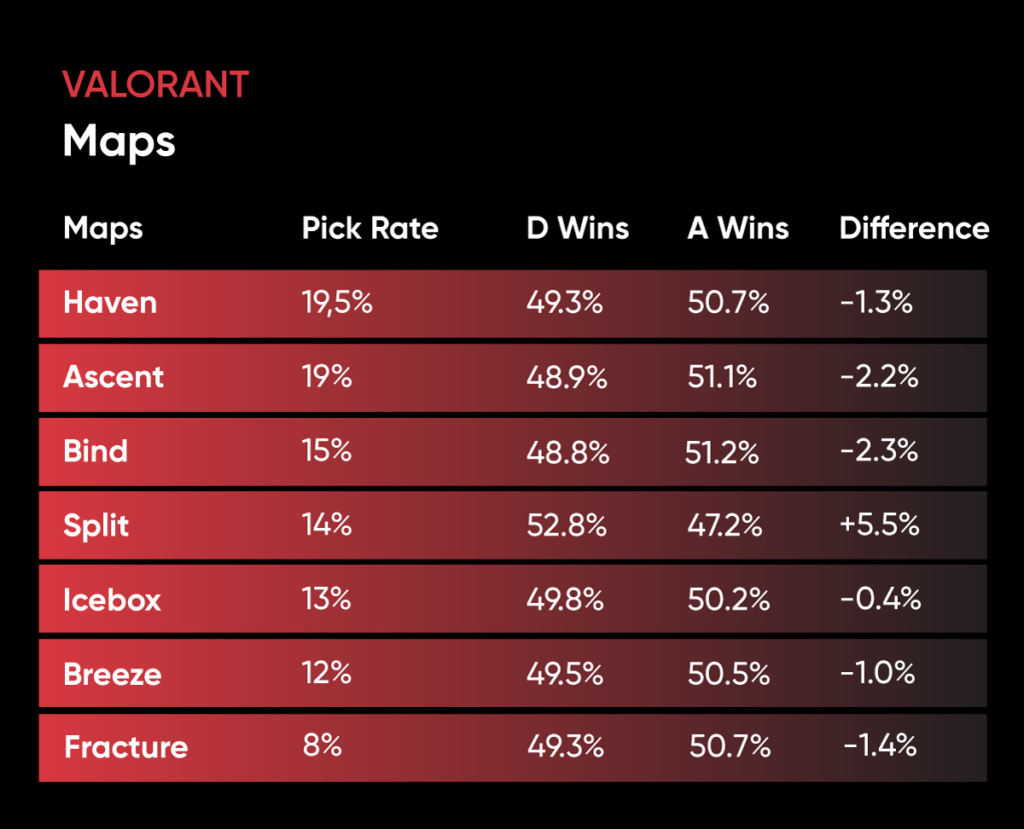
Find updated map statistics for 2023 here.
Is VALORANT a balanced game?
In general, the game is very balanced. As mentioned, some games have a selection of playable characters. When balancing these character traits, game developers need to consider the experience of both leisure players and the professional scene. This makes it harder, if not impossible, to create a hero pool where every agent sees an equal amount of play. With that said, Riot Games has already addressed this issue and changed Sova and Jett, hopefully allowing other agents to see more play.
In terms of weapons, many seem to be able to get the job done. Vandal and Phantom will remain the obvious choices when teams reach a healthy economy. A slight nerf to Vandal would probably give Phantom a well-needed edge. However, a new map with close-combat spaces could tip the scale in its favour as well.
Apart from the rifles, the Operator should either be buffed or cut in cost to be more affordable. Where it gives slight advantages in terms of control, it lacks in providing kills for its team compared to other, cheaper alternatives.
With regard to the different sites on the maps, they are very balanced with as little margin as 0,4% on Breeze.
Overall, the game is in a healthy place with a solid overall viewership and player base, which is only expected to grow over time as its esports scene matures. At Abios, we’re looking forward to the game’s development. We will continue to deliver its data to our customers, for esports fans to be able to follow the tournaments.
Who is Abios data for?
When creating a game website, odds modelling, covering a game in the news or creating a content platform, it is important to understand how a game works and its mechanics. With +9 years of historical data in the largest esports titles, we can see shifts in the overarching gameplay, as well as nuances you can only spot if you have large sets of data over time.
So whether you want to cover VALORANT for the latest news article, or build a VALORANT platform to track pro play, we can help you collect the right data for your needs.









